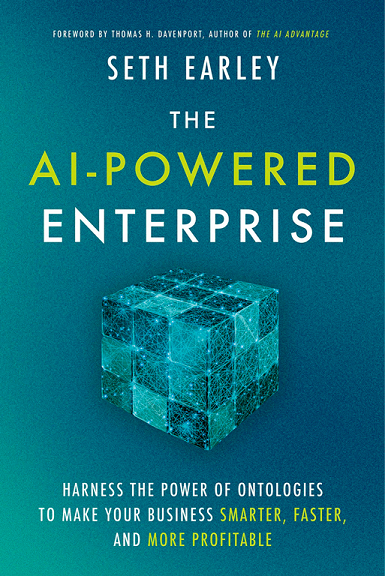Did you think you could just buy a nice Artificial Intelligence (AI) tool that will automatically turn your company data into useful insights, leaving the competition behind? Think again! The AI-Powered Enterprise by Seth Earley from 2020 is a fine book that explains that this is not how it works: first of all, you need an ontology! Uhm, what?
The book comes across as a bit outdated at first. After writing my RE thesis 20 years ago and working on taxonomies in the Dutch government’s SBR/XBRL program 10 years ago, I was surprised to notice that the data classification practices that were used back then are still valid today. Didn’t the rise of AI change anything? Yes and no, according to the book, which contains an extensive argument about the (continuing) need for an ontology as a foundation for AI applications.
But first: what is an ontology? In short: an architecture for information, containing categories for data, concepts, labels, taxonomies, relationships, acronyms, alternative spelling, technical standards, etc. The ontology’s purpose is to accelerate the information flow and, above all, to increase its relevance. The ontology connects the different systems across various departments through the use of shared tags.
Knowledge management and chatbots
That sounds a bit bureaucratic, but the example of a chatbot, in which you do not have to program all possible questions and answers in advance, but which can – through the use of an ontology – assume the intent of the questioner, is enlightening and relevant. I vividly remember an insurance company’s (programmed) chatbot trying to help me find the correct form to use for reporting my father’s death. This Artificial Intelligence did not understand my questions. The Human Intelligence I spoke to on the phone afterwards explained to me that I should have used the word “deceased” instead of “dead”.
The core of the book AI-Powered Enterprise is about knowledge management as well as “conversational AI” such as chatbots and virtual assistants. By devoting a chapter to each of the company’s key processes, Earley structurally tackles the topic of building an ontology and its use by AI applications.
Business processes
After two introductory chapters, which amongst others explain how to build an ontology, Earley discusses a number of business processes:
- Customer experience. This is mainly about the customer journey, often going through multiple departments and systems, and associated with various AI applications.
- Marketing. This chapter addresses the signals of customer needs (“breadcrumbs”, digital body language), and advertising being replaced by knowledge management in order to help the customer with their search for knowledge and insight.
- Ecommerce, which is mainly about product taxonomies and customer personas. While analyzing customer data, AI discovers many customer characteristics. It’s all about selecting those that match the company’s DNA , through an ontology.
- Sales. A lot of attention is paid to the transition of personal sales to online sales, and how AI can help turn leads into customers, for example through pattern recognition in conversations of successful salespeople.
- Customer service. How chatbots can help customer service do a better and faster job. Earley states that conversational AI is better than search AI: it answers your question instead of providing you with a whole reading list of documents.
- Employee productivity mainly focuses on knowledge management and how to structure unstructured data. Earley also distinguishes the discoverability of information depending on the degree of human control. His use of the employee journey is interesting.
- Production. This explains, among other things, how to test “digital twins” of new products with algorithms and how to use AI for transparency in the supply chain, which is important in the context of sustainability and child labor.
- Strategy and governance. This highlights on the one hand how AI can be used to analyze governance and culture (such as using metrics on diversity and leadership) and on the other hand how to organize and manage AI projects. Of interest are the Maturity models for the different business processes, because, according to Earley, AI applications require mature, well-managed processes.
Evaluation
The overview of possible AI applications per business process is clear and detailed, great or even perfect for a target audience that is not quite “AI-savvy” yet. Each chapter has a short overview of Takeaways, which is very practical. I did not find the book surprising or innovative, it mainly covers digital optimization, not transformation; nothing changes in the design of the processes or in the business model. In addition to that, the process-oriented layout causes a lot of repetition and overlap.
In general, I would say that Earley states many things but provides little evidence. Earley only provides (often dated) examples from his own consulting practice, in which an ontology was of great value to companies that previously had problems with their AI projects. The book merely touches upon the possibilities of having an ontology built by AI itself, while hardly addressing circumstances in which an ontology would not have additional value.
I read the eBook, which is not ideal in terms of tables and figures. Earley has of course noticed this as well and refers to a website to have a better look. Also, the index is not entirely correct because the hyperlinks refer to the page numbers of the printed book, which is obviously less convenient for an eBook. I would have expected an expert in digital transformation to come up with something more innovative.
Earley, S. (2020). The AI-Powered Enterprise: Harness the Power of Ontologies to Make Your Business Smarter, Faster, and More Profitable. Los Angeles: LifeTree Media (ISBN 9781928055501).




